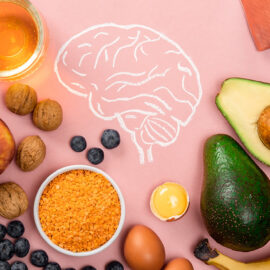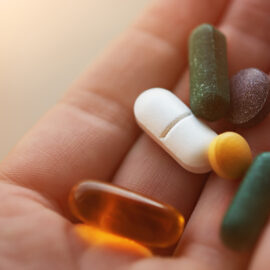Aside from water, proteins are the most abundant molecules in the human body and is the major structural component of all cells. In addition to helping the body repair cells and make new ones, protein is important for growth and development in children, teens, and pregnant women. As humans age, it’s even more crucial to consume enough high-quality protein in the diet to better preserve muscle mass and strength, increase the body’s immune function, help decrease recovery time from illness, and maintain a certain quality of life.1
Healthcare professionals know that protein is vital for health and fitness. Yet, while a towering body of research supporting the adequate consumption of high-quality protein has become mainstream, numerous misconceptions have surfaced in media causing confusion amongst consumers. A cross-sectional study analyzing protein trends from the National Health and Nutrition Examination Survey, 2001-2014, found that dietary protein intake was well below the upper end of the Acceptable Macronutrient Distribution Range (AMDR). In addition, results revealed that a considerable percentage of adolescent females (14–18 y) and older adults (≥71 y) fall below the recommended dietary allowance (RDA).2 This data further supports the importance of healthcare professionals to debunk protein myths and encourage adequate protein intake at levels to optimize health.
Here are three of the most common protein myths with science-backed facts.
1. Individuals can’t get enough high-quality protein on a plant-based diet
Protein quality is based on the content of essential amino acids in a food and their bioavailability. The digestibility of protein suggests the proportion of ingested nitrogen or amino acid made available after digestion and absorption.3 Currently, the Food and Drug Administration (FDA) uses the Protein Digestibility-Corrected Amino Acid Score (PDCAAS) to measure protein quality in foods. The PDCAAS evaluates the quality of protein based on the amino acid requirements that humans require.
While the PDCAAS tends to indicate animal protein sources (i.e., meat, seafood, dairy) rate higher than plant protein sources due to higher digestibility and distribution of the nine essential amino acids, research has shown that when a variety of plant foods are ingested, overall protein and essential amino acid needs can be met adequately in adults.4 Conversely, children that are consuming enough calories to meet their needs for growth are usually able to meet daily protein needs on a vegetarian diet. Whether on a vegetarian or vegan diets, it’s important for individuals to consume a variety of protein-rich plants such as legumes, nuts, and seeds, and to be counseled on ways to enhance their nutrition with supplementation, if needed.
2. Eating too much protein can negatively impact kidney function and weaken bones
Over the years, the myth suggesting too much protein will impair kidney function has been a topic of misinformation circulating in the popular media surrounding high protein diets. However, the one major caveat is people with pre-existing kidney disease. Individuals with impaired kidney function are not able to efficiently remove all the waste from protein in the diet. For this population, a higher protein intake (1.4g/kg/day or more) has been associated with a higher mortality rate whereas lower intakes of dietary protein were not associated with mortality.5 However, there is a lack of evidence showing a detrimental effect of high protein intakes on kidney function in healthy people. Recent research states that people with normal kidney function and a low dietary protein intake (less than 0.6g/kg/day) was associated with higher mortality, whereas higher dietary protein intake levels were not associated with death. 5
While it was once suspected that bone was impacted by the acid generating components of a high-protein diet, updated literature indicates that greater protein does not negatively affect bone health. According to the International Osteoporosis Foundation, adequate dietary protein is “essential for optimal bone mass gain during growth and also for preserving bone and muscle mass with ageing.”6
3. Cutting back on protein can lead to weight loss
One of the many functions of protein is that it can help to increase satiety or feelings of fullness, which can indirectly help with weight loss. According to a substantial body of evidence, high-protein (1.2-1.6g/kg), energy restricted diets have showed greater weight loss, fat mass loss, and preservation of lean mass compared to low-protein, energy-restricted diets. In addition, spreading protein intake throughout the day in quantities of 25-30g protein per meal has shown improvements in appetite, body weight management, cardiometabolic risk factors, or all these health outcomes.7
Known as the “hunger hormone”, ghrelin is a hormone produced and released in the stomach which signals the brain when the stomach is empty and it’s time to eat. In contrast to the hormone leptin, which decreases appetite and signals the brain that the stomach is full, ghrelin has been associated with increased appetite. Decreased levels of ghrelin have been related to decreased appetite which can in turn increase weight loss. When it comes to the impact of dietary protein, research has shown there to be a significant reduction in ghrelin over time when consuming higher-protein diets compared to carbohydrate diets.8
The Role of Healthcare Professionals
Healthcare professionals have the unique opportunity to better guide their patients in understanding important macronutrients like protein and clearing up the confusion that may be steering them away from getting adequate daily intake. However, before debunking protein myths with clients, it’s important to first gauge their understanding on what protein is. Once this is established review the different dietary sources (plant and animal), the many roles protein plays in the body, and the importance of daily consumption spread throughout the day. For a comprehensive overview of protein and current dietary recommendations, check out part 1 of this two-part protein education series, Demystifying the Role of Protein in Human Health.
Orgain = High-Quality Plant-Based and Grass-Fed Whey Protein
At Orgain, we understand the desire for healthcare professionals to recommend high-quality protein products and ingredients to those they serve. We’re proud to share that all our products are reviewed and certified for quality by a recognized 3rd party, and all our suppliers are regularly audited for quality assurance. In addition to Orgain’s line of grass-fed whey protein powders, our plant-based protein powders provide a complete source of protein with all nine essential amino acids. For your patients following renal diets and seeking higher-quality nutrition to meet their needs, check out our downloadable resource, Orgain Renal-Friendly Products.
- Baum, J. I., Kim, I.-Y., & Wolfe, R. R. (2016, June 8). Protein consumption and the elderly: What is the optimal level of intake? Nutrients. Retrieved March 2, 2023, from https://www.ncbi.nlm.nih.gov/pmc/articles/PMC4924200/
- Berryman, C., Lieberman, H., 2, & 3. (2023, February 2). Protein intake trends and conformity with the dietary reference intakes in the United States: Analysis of the National Health and Nutrition Examination Survey, 2001–2014. The American Journal of Clinical Nutrition. Retrieved March 2, 2023, from https://www.sciencedirect.com/science/article/pii/S0002916522029215?via%3Dihub
- Tomé, D. (2013). Digestibility issues of vegetable versus animal proteins: Protein and amino acid requirements—functional aspects. Food and Nutrition Bulletin, 34(2), 272–274. https://doi.org/10.1177/156482651303400225
- Mariotti, F., & Gardner, C. D. (2019, November 4). Dietary protein and amino acids in vegetarian diets-A Review. MDPI. Retrieved March 2, 2023, from https://www.mdpi.com/2072-6643/11/11/2661
- Narasaki, Y., & Okuda, Y., et al, (2021). Dietary protein intake, kidney function, and survival in a nationally representative cohort. The American Journal of Clinical Nutrition, 114(1), 303–313. https://doi.org/10.1093/ajcn/nqab011
- Protein and other nutrients: International Osteoporosis Foundation. IOF International Osteoporosis Foundation. Retrieved March 2, 2023, from https://www.osteoporosis.foundation/health-professionals/prevention/nutrition/protein-and-other-nutrients
- Leidy, H. J., & Clifton, P. M. (2015). The role of protein in weight loss and maintenance. The American Journal of Clinical Nutrition, 101(6). https://doi.org/10.3945/ajcn.114.084038
- Missimer, A., & DiMarco, D. (2017). Consuming two eggs per day, as compared to an oatmeal breakfast, decreases plasma ghrelin while maintaining the LDL/HDL ratio. Nutrients, 9(2), 89. https://doi.org/10.3390/nu9020089



